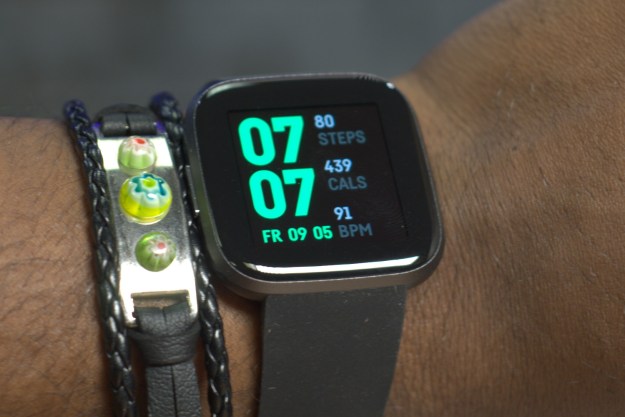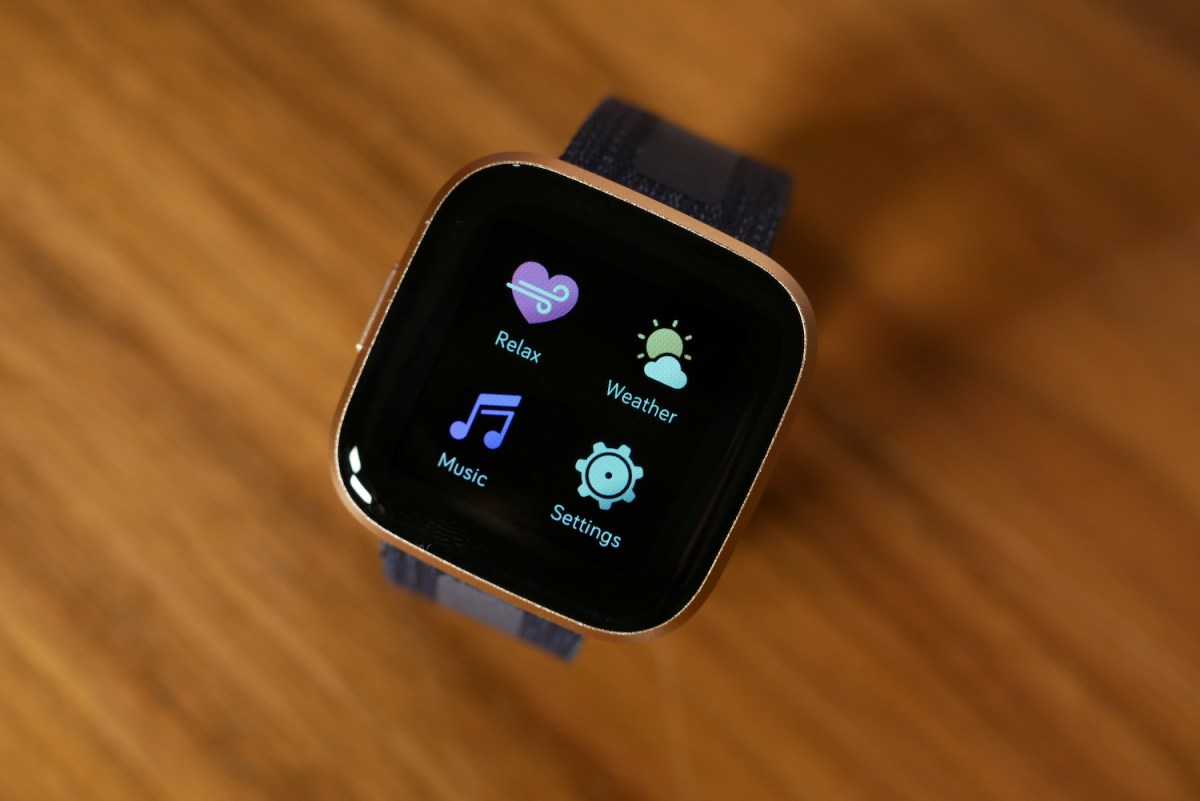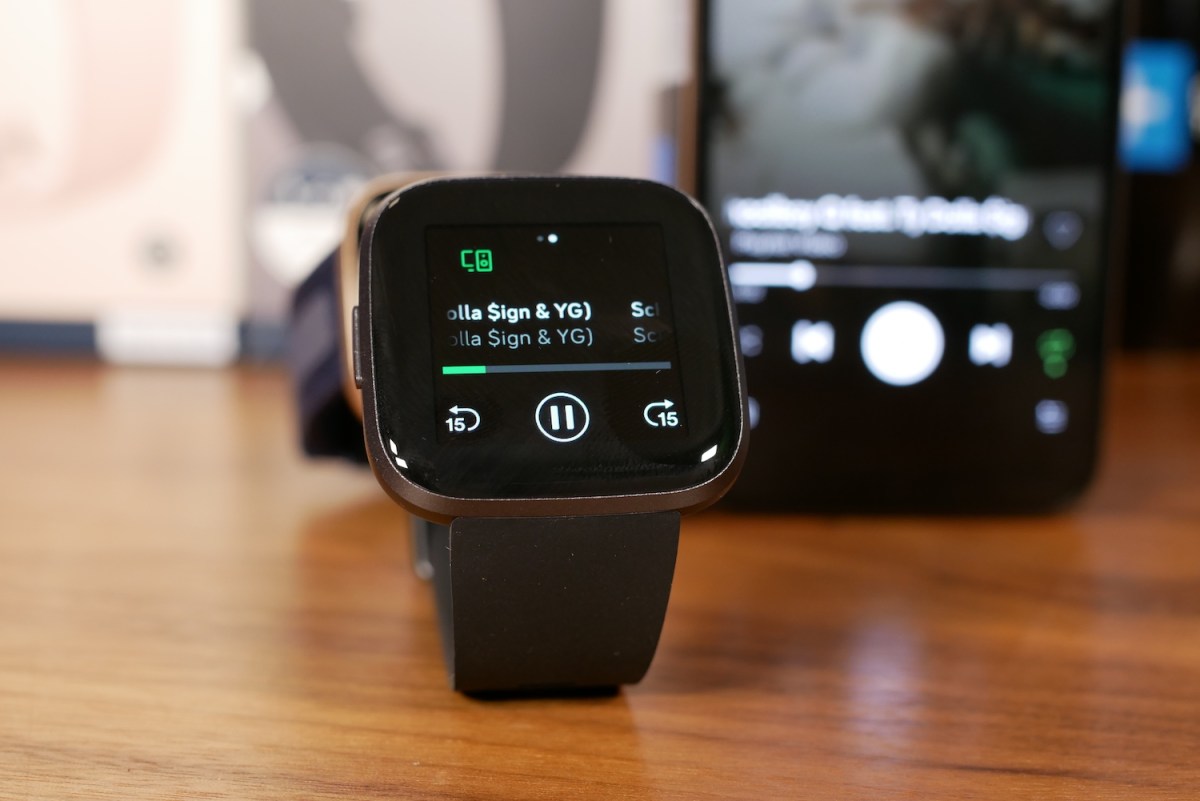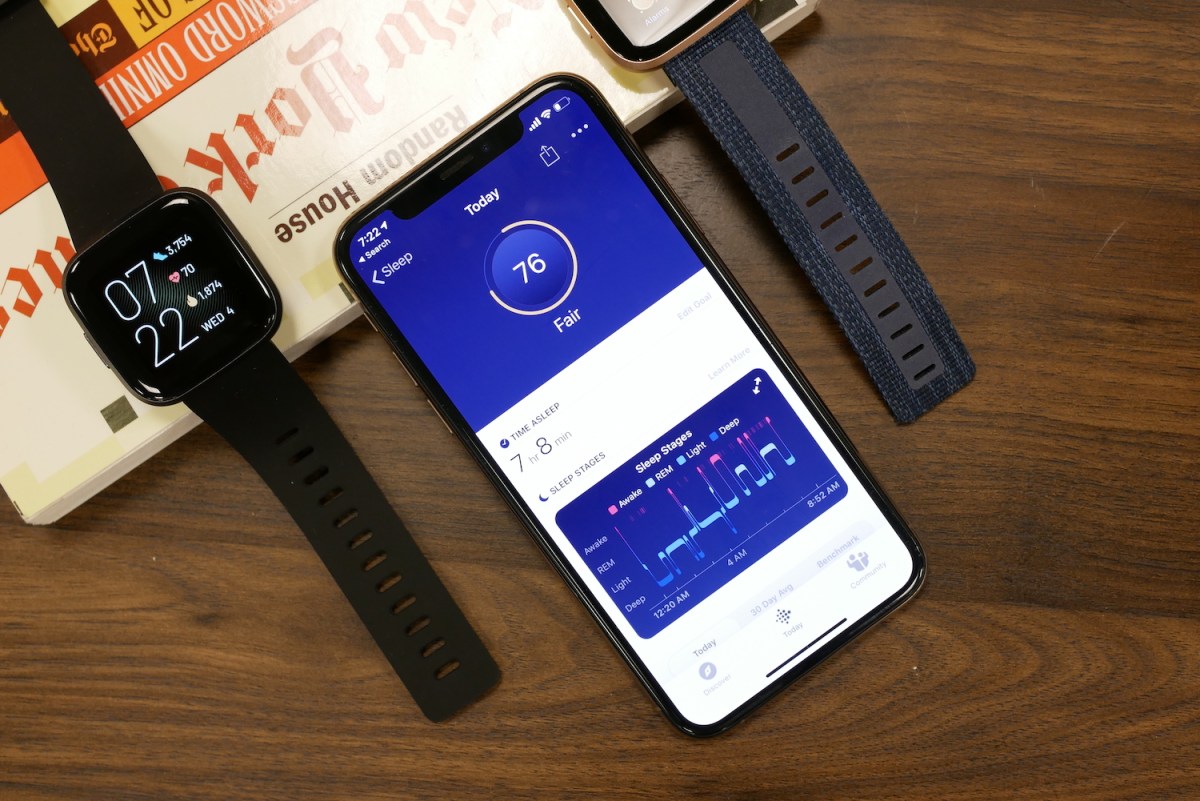
“The Fitbit Versa 2 has excellent battery life, but important fitness insights are locked behind a subscription.”
- Affordable
- Multi-day battery life
- Native sleep tracking
- On-device music storage
- Intuitive interface
- Offers few insights (without paying extra)
- Can’t stream from Spotify
- Looks like an Apple Watch knock-off
- Alexa is largely useless
When the Fitbit Versa debuted, it filled a niche for people who wanted smartphone notifications but championed wellness first. It was a good compromise between the two, but didn’t deliver fully in either regard.
The Fitbit Versa 2 is even more like a smartwatch than ever before, with Alexa and Spotify integration as well as an AMOLED screen. However, fitness insights come at a cost with Fitbit Premium, a new subscription service. The paywall for more detailed insights leaves much to be desired for data-hungry athletes, but the Versa 2 is still a strong contender in a crowded space.
New AMOLED display, same design
The Versa 2 looks an awful lot like the Pebble Time grew up to be an Apple Watch, albeit slightly wider and missing Apple’s rotating crown. The chamfered edges of the casing offer some distinction, but I couldn’t stop seeing an Apple Watch knock-off every time I looked at the Versa 2.
Build quality is better than any knock-off though. It feels solid, lightweight, and well-crafted. The included silicone band is a different story, as the band is rather stiff and doesn’t quite hug the wrist without having to tighten it beyond a comfortable level. These two attributes together caused me some irritation at first. The stiffness of the band fades away the longer you wear it, but I still found myself adjusting the Versa 2 on my wrist, more so than I would with a snugger-fitting and softer strap.

Fortunately, there are replacement bands that offer more style, functionality, and in some cases, comfort. I threw on the woven-leather Kim Shui designer band, as well as a reflective woven band made of recycled materials. The former offered the most comfort of the bands I tested, while the reflective band, predictably, was stiff and scratchy, though I did get used to it.
The most noticeable upgrade comes from the newly-added AMOLED display. There’s now an always-on display, just like the new Apple Watch Series 5, and it’s nice to be able to glance at the time and activity progress without fussing with the watch. It weirdly disables the lift-to-wake function without any indication that it will no longer work, though. If you have the always-on display enabled, you’ll have to use the button to wake up the Versa 2 or tap on the screen.
Otherwise, I had no trouble reading the screen in direct sunlight, and the deep blacks — thanks to the AMOLED panel — help fade the thick bezels around the screen out of existence.
Visually, the Versa 2 is hard to distinguish from its predecessor. On closer inspection, you will see the watch face’s bezels are now smooth and rounded, as is the optical heart rate monitor in the back. Other changes include a slightly bigger battery, an upgraded processor, NFC for Fitbit Pay, but we’ll get to that next.
Using the Versa 2
Navigating the Versa 2’s operating system is a relatively smooth experience, though some animations stutter now and then. There are no persistent hangs or other notable detriments to speak of (unlike what I regularly see on Google’s Wear OS smartwatches).
Operating it is a straightforward affair: there’s only one button, which serves as a back button via short press and an Alexa or Fitbit Pay shortcut with a long press. Swipe right from the home screen for apps like exercise, alarm, clock, and third-party apps like Spotify, and pull down from the top for notifications and quick settings. New to quick settings is a sleep mode toggle that enables do not disturb and turns off the screen.

Spotify integration is a new addition for the Versa 2, but it’s limited in two key ways. First, you must have a premium Spotify subscription to use this. Bummer.
Second, it doesn’t allow playback from the Versa 2, but only controls playback on another device, like your phone or smart speaker. It’s a nice bonus, but I want the ability to stream a playlist or two from Spotify to Bluetooth earphones without needing to bring my phone on my run. This integration falls a bit flat.
That being said, you can store music on the device, about 300 songs, via a desktop Fitbit app. Unfortunately, these all must be loaded over Wi-Fi as there is no option to transfer via a wired connection, so it can take some time. Pandora and Deezer offer offline playback, as well, with their paid subscription services.
Alexa’s debut on the Versa 2 should, in theory, help bring this fitness wearable firmly into the smartwatch ranks. In reality, Alexa is mostly useless. Issues with voice recognition and the lack of useful search results make it feel far from polished on the Versa 2.
You must have a premium Spotify subscription to use this. Bummer.
Alexa was able to answer basic questions like, “Show me the weather,” and you can then tap into the response to see a 7-day forecast. Asking Alexa queries like, “Who was the first president?” will bring up a text answer as well, but you can’t tap it to see more information on the device or on your phone.
Similarly, asking, “What restaurants are nearby?” will bring text on-screen with only three options and you aren’t able to follow up or explore these options in any way. I also had to repeat several of these queries multiple times because Alexa had trouble understanding me. It was frustrating.
Otherwise, you’re going to find a lot of software functionality overlap between the Versa 2 and Wear OS watches. Third-party apps like Uber, Philips Hue, and Starbucks Card are available on the Fitbit Versa 2, and you can even respond to text messages with preset replies or your voice (limited to Android).
Wellness support and the Fitbit App

The Versa 2 is a rather easy device to use while working out; music controls are a couple of swipes away, and real-time exercise metrics are viewable on the always-on display, so you don’t ever feel like your getting out of “the zone” to quickly glance timing or skip to the next track if the current one isn’t doing it for you.
The reflective bands aren’t water or sweat resistant in any way, so you’ll want to use silicone bands when working out, or else risk soaking or ruining the recycled material or leather bands.
On the watch, you can see steps, calories, heart rate, and activity minutes and initiate workouts from seven different exercise modes: running, cycling, swimming, treadmill running, and weight training, as well as a general exercise tracking option and an interval training mode, which structures a timer for a 10-minute interval training. There’s a vibration prompt at each interval for activity and for rest.
Exercising and tracking your health with the Versa 2 is simple and the results are accurate, but the data gathered in the Fitbit app could be more insightful. For example, Fitbit trackers have long monitored sleep, measuring duration and the different stages. New to the equation is a zero to 100 scoring system, which distills this data into a number.
“76, Fair.” Outside of 0ne-sentence explainers on what each sleep stage means, there’s no context to help you sleep more efficiently or better understand your sleep in any way. Neither the sleep score nor the logged data provide anything to actually help improve your sleep.
The only way to get actionable insights is through the soon-to-be-launched Fitbit Premium membership.
I’ve seen more insightful explanations from Huawei Health, the companion app for Huawei’s wearables, which not only offers paragraphs of sleep information but also tips on how to get better sleep, even if it’s not always personalized. By the same token, Samsung’s Galaxy Wearable app and watches like the Galaxy Watch Active offer more specialized workout modes — seven with automatic detection and 39 more manually-enabled modes — with more insights and tools, like a running coach, during and after the activity to further your wellness goals.
One of Fitbit’s main advantages is its community aspect. Similar to social media, the Community tab offers a news feed which you can tailor to your wellness interests or look through the general feed to see, like, and share tips, motivation and progress within the vast community. There’s millions of users on here, 27 million to be exact, and you’re sure to see some truly motivating stories of transformation, perseverance, and the daily grind. Scrolling through a feed of real people’s journeys, and seeing everyone else put one foot in front of the other, it’s hard not to feel motivated to keep at it. Best of all you can connect with strangers and your own friends for fitness challenges to make things even more personal. Certain challenge types are restricted to the paid subscription, though.
Speaking of which, the only way to get actionable health insights is through the soon-to-be-launched Fitbit Premium membership. For $10 a month or $80 annually, the company will provide guided workouts, printable health reports, and overall more personalized insights and guidance for your sleep, exercise, and wellness goals.
There will also be an option to work with a certified health coach, for an additional charge, to help create and adhere to a plan based on your Fitbit data and goals, as well as receive insight and referrals for your health concerns. Access to a coach is one thing, but it’s irritating that insights to your health beyond a few uncontextualized numbers are now hiding behind a paywall.
The Versa 2 will add a smart wake feature soon, which attempts to improve your sleep by waking you up in a light sleep stage rather than exactly when your alarm is set — up to a half-hour before your alarm time. I didn’t get to test this as its yet to debut, but similar features exist on other devices and could help you wake up easier if the timing is right.
Three-day battery life
The standout feature of the Versa 2 is its battery. On average, I managed between two and three days of mixed usage on from the Versa 2. I’m not a light user.
Given its smartwatch functionality, I enabled all of my most important notifications (about six active apps for news and messaging). I used sleep tracking nightly, had about 30 minutes of exercise daily, and all of that was with the always-on display enabled. If you don’t work out every day, expect the Versa to last fully through day three.
This is on par with the Samsung Galaxy Watch Active, a similarly-priced fitness-focused smartwatch. The Apple Watch can only go through a day and a half, if not two days with light use, and most Wear OS smartwatches last a full day and not much more.
Our Take
The Fitbit Versa 2’s biggest strength is its three-day wearability on a single charge, but that’s not much different from last year’s Versa. Fitness insights and app support are limited — especially with music — and Alexa doesn’t add much value. Competitors like the Galaxy Watch Active and the Apple Watch Series 3 — which can now be bought for $200 — make the Versa 2 a tougher sell now than its predecessor was a year ago.
Price, availability, and warranty information
The Versa 2 costs $200, or $230 for one of the two special edition colors, with replacement bands ranging from $30 to $100.
Fitbit offers a 45-day money-back guarantee as well as a one-year limited warranty and an optional two-year protection plan against damage, sold through Square Trade for $44.99. This carries a $30 deductible per claim.
If you’re hoping to find a discount, take a look at the best cheap Fitbit deals and best smartwatch deals available now.
Is there a better alternative?
For iPhone owners, that’s an easy answer — the Apple Watch is a much better alternative. Better yet, Apple has dropped the price on the Series 3 to $200, and it’s still an excellent contender despite coming out in 2017. You’ll have deeper smartphone support with your iPhone, GPS built-in, and access to a number of third-party fitness programs and tracking apps. The only downside? There’s no native sleep tracking, and the watch will require charging at the end of each day.
If you splurge on the new Apple Watch Series 5, you’ll get an always-on display, better battery life, and even a built-in compass, but there’s still no sleep tracking. We also have a head-to-head comparison of the Apple Watch Series 5 vs. Fitbit Versa 2. If you’re stuck between the Fitbit Versa 3 and the Fitbit Versa 2, check out if we think the newer version is better than the older one.
As for Android owners, you can get a much better-looking smartwatch with built-in GPS, and it’s called the Galaxy Watch Active from Samsung. It even has two days of battery life at the least, as well as sleep tracking capabilities. Best of all, you can download Spotify playlists to listen offline.
How long will it last?
With water resistance up to 50 meters and solid build quality, the Versa 2 should last you two to three years or more quite easily.
Should you buy it?
No. The Galaxy Watch Active can do almost everything the Versa 2 can, and it looks more stylish; the upcoming Galaxy Watch Active 2 steps it up even further for just a little more. And if you don’t care about sleep tracking, the Apple Watch is perfect for iPhone owners.



